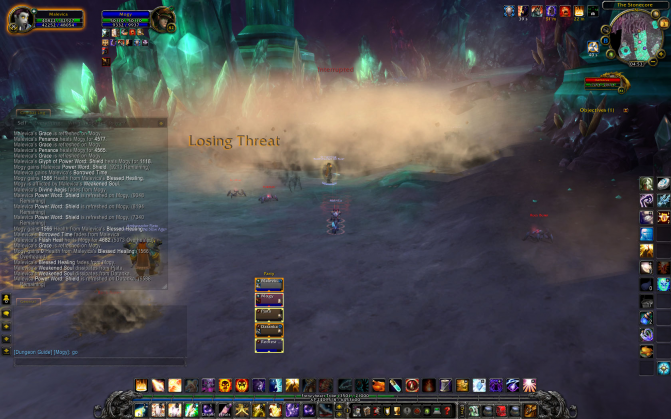
Well, OK, I do enjoy topping the meters from time to time when I really get into my groove or a fight seems tailor-made to a Priest’s healing style (I’m looking at you, Atramedes and Nefarian!), that’s just natural.
What I’m talking about is the conflict between being a big fish in a small pond and being a small fish in a large pond.
Fish?
It’s a metaphor.
As I’ve progressed through this game, the average skill and potential of the guilds I’ve been in has tended to improve each time, from the guild where the Maiden of Virtue was an insurmountable challenge to becoming stuck at Kael’Thas (twice) and finally to my present guild.
In each of my previous guilds (not this one!), I’ve eventually found myself topping the meters on a consistent basis, either as a damage-dealer or healer. Now I know that meters suck, healing meters in particular, that they don’t tell the whole story and that there’s more to a player than their ranking. So don’t write in! Just consider it a shorthand for “performance”, OK?
The point is, eventually you may simply outgrow your guild, you become the big fish in your guild’s small pond, and it may well be time to consider moving on.
What’s wrong with being the big fish?
If you’re happy where you are, then stay where you are. But there are some pitfalls to being the big fish.
Frustrated potential – This is probably the most significant problem you’ll find, sooner or later. If the rest of your guild is ‘lagging behind’ you in terms of performance, then you might not be experiencing the level of content, with all its associated challenges, that you really need to give you a truly fulfilling gaming experience.
This is a common source of friction in just about all raiding teams, and is very difficult for leadership to manage because the solutions take time, or might mean an unacceptable compromise on principles. You can’t simply “kick the bads and recruit better players” (because they might not want to join you, or their desires and needs might conflict with the guild’s founding principles) and nor can you expect a Hollywood-style inspirational speech (and certainly not a rant) to instantly boost your raid’s DPS output by 30%.
Usually a move to a more progressed guild is the eventual outcome. If you’re willing to stick with the guild though and work patiently with your guildies to develop their skills and inspire them to greater things, you may earn yourself a lot of respect and some friends for life.
No yardstick – The question every raider should be asking themselves is: “how am I doing”, followed by: “how can I do better”. When you’re in a situation where you have little or no competition, you will struggle to answer those questions and that can easily lead to stagnation.
Accepting that healing meters on their own don’t tell the whole story (or damage meters, to a lesser extent), they can at least be an indication of how you’re doing as a raider. If you’re always head and shoulders ahead of your classmate and it can’t be put down to assignments or fight mechanics, you have no immediate pressure to improve, nor any inspiration to derive from them.
This one can be a slow-burner, but eventually you will probably begin to feel like you want to feel a challenge to hone your skills, and to have someone to look up to and emulate.
The pressure to attend – While it might be great to be your team’s all-star player, particularly in smaller teams your presence might be make-or-break for success in a particular fight; or at least you might have that impression. Either way, that can lead to a strong sense of obligation to be at every raid.
Quite apart from the pressure being problematic in its own right, everyone needs a guilt-free night off from time to time after all, it also locks you into a class and spec. If you’re irreplaceable, you don’t have the freedom to change your mind at will, which might also trigger a change of guild.
Resentment – Finally, there’s the ever-present human nature to consider. This one depends strongly on your guild and team, and how you present yourself within that team, but there can be a certain resentment of the big fish that builds over time.
Maybe someone is worried that they’ll never get a regular raid spot while you’re around; maybe they don’t want your advice on how they can improve; maybe they think you’re trying to pull the guild in directions they don’t want it to go.
Whatever the reason, and however well-founded it might be, these feelings are real and can be very destructive if not dealt with. It’s possible that you can change how you interact, but maybe it can’t be fixed and a change of scenery ensues.
What about the small fish?
Well, unless you make only the tiniest step up the progression ladder, chances are you’ll find yourself struggling to keep up and maybe fighting for your survival within the guild. How much of this you subject yourself to depends on how ambitious you were when picking your new guild.
To make matters worse, your skills are likely to be at least a little rusty. That’s either the reason for the move or a likely corollary. So it’ll take a bit of time to stretch out your muscles and perform at your best.
The transition can be very tough. The automatic respect that came from being thought of as a “good player” in your old guild won’t be present in your new guild, which means you have to be very careful how you offer comments and suggestions. And, regardless of what anyone says, it is nice to see yourself on top from time to time.
Get through it though, and maybe you’ve found your new home. At least for a while…









